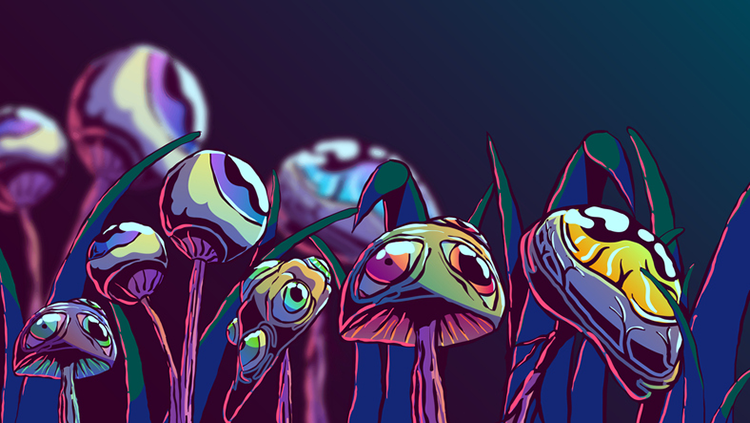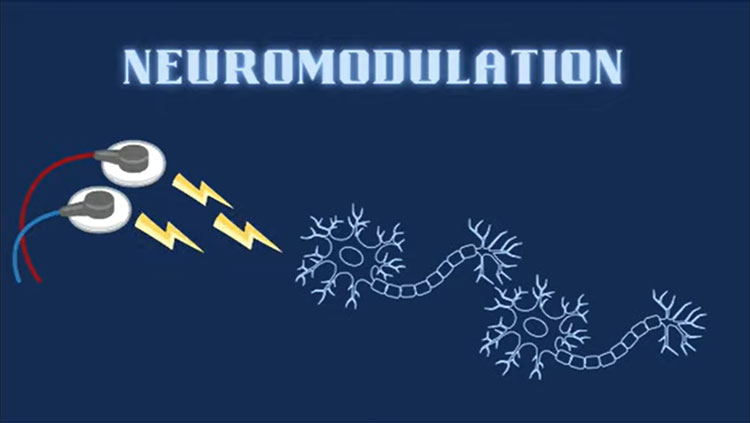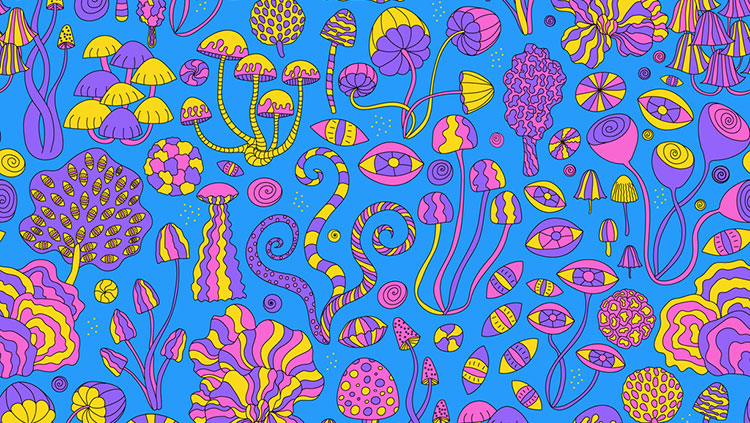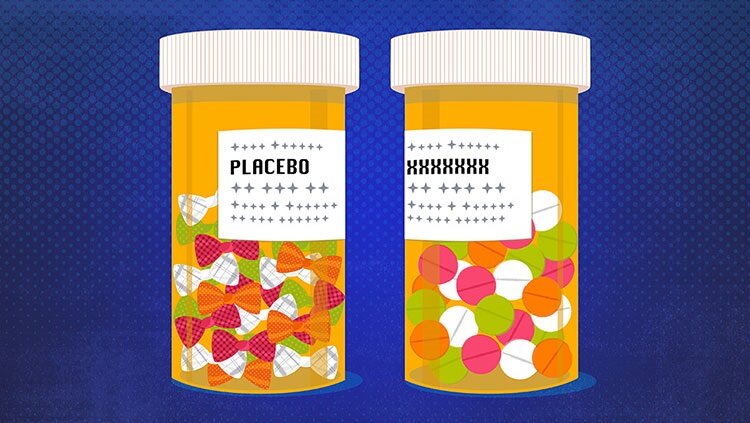Mind-Bender, Mind-Fixer? Researchers Investigate Targeted Psychoactive Therapies Without the Trip
- Published2 Aug 2023
- Author Karen Hopkin
- Source BrainFacts/SfN
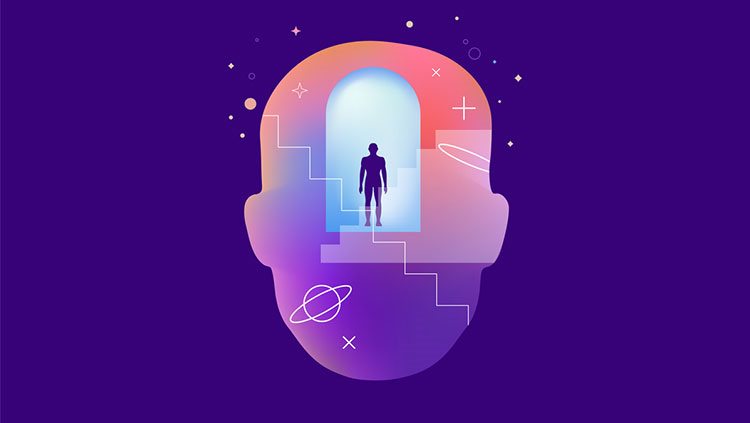
The drug takes about ten minutes to kick in. “Then it’s like a rocket ship taking off,” says *Mark M., whose depression interferes with his enjoyment of life. “For me, time and sound get very distorted. I like to listen to music, and a song that’s two or three minutes long feels like it goes on forever.”
If this experience sounds like a hallucinogenic trip, it was. But it took place in a psychiatrist’s office, where Mark spritzed a pharmaceutically formulated dose of ketamine into each nostril.
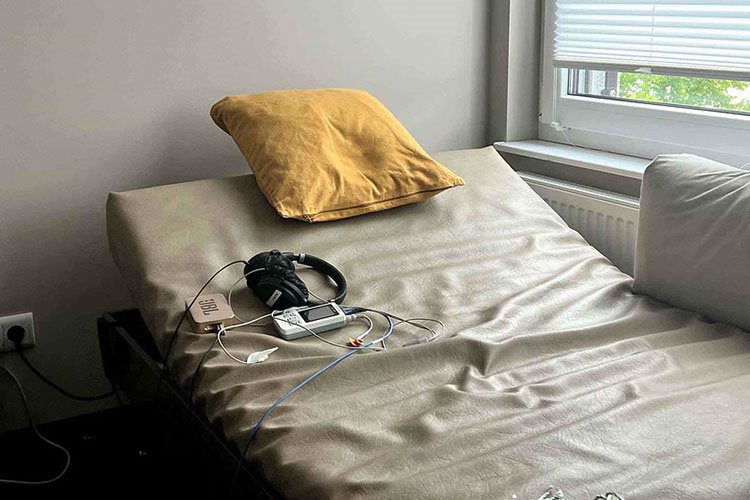
And Mark is not alone. Although many people suffering from mental health issues attempt to self-medicate to boost their mood or relieve stress with sometimes devastating results. Even so, psychoactive substances such as ketamine, psilocybin, and even cannabis are showing therapeutic promise in clinical trials and in animal models for anxiety, migraines, obsessive-compulsive disorder, and treatment-resistant depression.
These consciousness-altering compounds operate on distinct neural circuits and through different neurotransmitter systems. However, researchers are finding they all strengthen neuronal connectivity. Pinpointing how they do so could lead to more targeted and effective therapeutics — perhaps even producing clinical benefits while circumventing the reality-warping sojourn.
Probing Plasticity
The recreational and ritualistic use of psychedelics is as old as humankind. But interest in the therapeutic potential of these substances ignited in 2016, when a pair of placebo-controlled trials showed that a single dose of psilocybin, the active ingredient in “magic mushrooms,” curbed depression and anxiety in individuals with life-threatening cancers. The effects were not only immediate, but the majority of volunteers continued to benefit six months after the treatment. Similar results have been seen with other psychedelics and with ketamine, a non-psychedelic hallucinogen.
“I was in the room,” says Natasha Mason, an assistant professor at Maastricht University. Mason and colleagues at Maastricht study the effects of a psychedelic naturally found in toad venom on individuals with treatment-resistant depression. “Some seemed like a whole new person. And most were still in remission a week later” — the duration of the initial, proof-of-concept study.
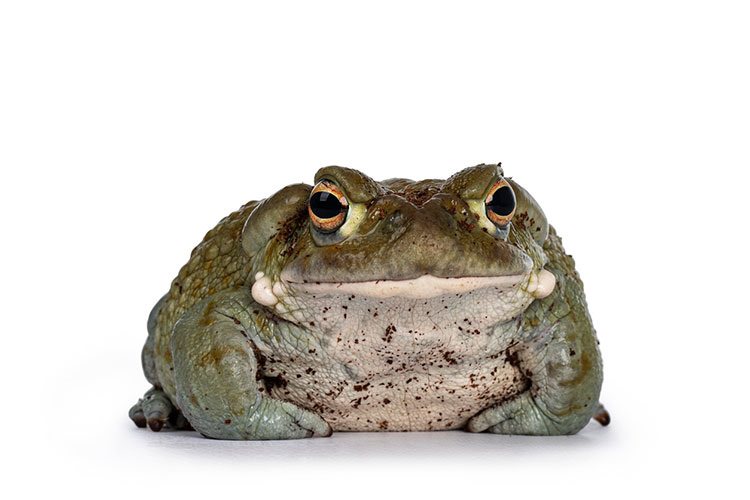
The persistence of therapeutic benefits long after these drugs have been cleared from the body appears to be tied to their ability to enhance neuroplasticity, promoting the growth of neuronal connections. Using a technique for live brain imaging in mice, Alex Kwan, associate professor at the Meinig School of Biomedical Engineering at Cornell University, discovered a single dose of psilocybin boosts the density of synapses in the frontal cortex. “When we go back a month later,” he says, “some of those new connections are still there.” And studies demonstrate, in the case of ketamine, selectively eliminating these drug-induced connections quashes the antidepressant activity.
Understanding the mechanisms by which drugs like ketamine and psilocybin — and even the antidepressants currently on the market — regulate neuroplasticity and mood could uncover common molecular targets or pathways that could lead to the development of more effective, longer lasting treatments. “Perhaps ketamine could be used to initiate the cascade, but another drug that targets a downstream component of the pathway could sustain the effects,” says Lisa Monteggia, professor of pharmacology and Barlow Family director of the Vanderbilt Brain Institute at Vanderbilt University in Nashville.
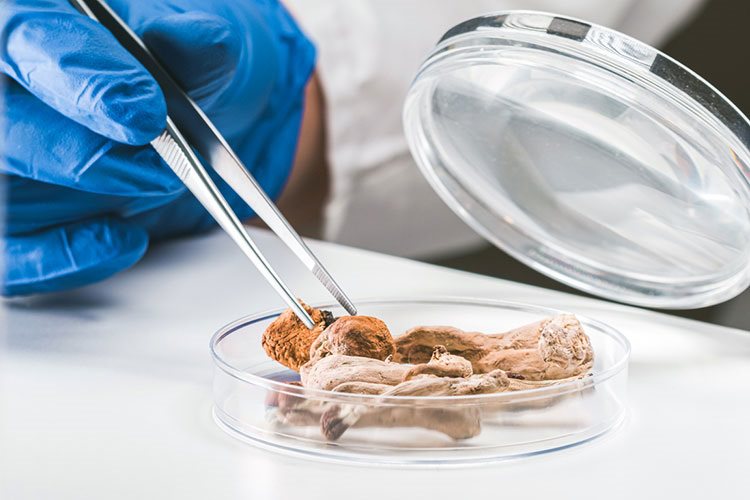
Such reinforcement doesn’t even have to be pharmaceutical. It could come from something like transcranial magnetic stimulation, or even cognitive behavioral training, or talk therapy applied during the period in which neural plasticity continues to be elevated. “We could capitalize on that window of opportunity to enhance the therapeutic potential of these substances,” says Mason.
Passage Without the Trip
But not everyone is keen on a hallucinogenic odyssey — much less an ongoing series of them. “It can be an amazing experience,” says translational neurobiologist and clinical neurologist, Gitte Moos Knudsen, at the University of Copenhagen, who notes it’s often quite exhausting. “It’s not something you want to repeat too often.”
Knudsen’s work finds psychedelics disrupt the normal communication circuits within the cerebral cortex, an action that may contribute to the feeling of detaching from oneself and transcending time and space.
Can these drugs provide clinical benefits without the mind-altering experience?
For those considering a psychoactive therapy, the question then becomes: Can these drugs provide clinical benefits without the mind-altering experience? It’s possible a change in perspective actually facilitates the therapeutic process, allowing individuals to abandon obsessive rumination and establish healthier patterns of thinking and behaving.
At the same time, a growing number of studies suggest the trip may not always be required. In research presented at Neuroscience 2022, Katherine Nautiyal, assistant professor of psychology and brain sciences at Dartmouth College, finds psilocybin’s ability to relieve certain depressive behaviors in mice may depend on its ability to interact with a subtype of serotonin receptor not known to be involved in the chemical’s hallucinogenic effects. Although Nautiyal is ultimately agnostic about the potential for decoupling psychedelics’ clinical and consciousness-altering effects, she stresses that “understanding the changes that are occurring in the brain to support their long-term therapeutic benefits could open up new avenues for understanding how to treat depression.”
Others are using the powers of chemistry to design molecules that interact with the serotonin receptor associated with psychedelic effects, but by inducing plasticity without triggering hallucinations. Using a computational approach, Bryan Roth, the Michael Hooker Distinguished Professor of Pharmacology at the University of North Carolina, Chapel Hill, has screened trillions of novel molecules for their ability to interact with the psychedelic serotonin receptor. Of those, Roth says, two show antidepressant-like activity, but no psychedelic action in mice. “Of course, we also discovered tons of new psychedelics,” he adds. “But we don’t feel like the world needs more of those right now.”
"Over the last few years, several labs reported about a dozen new compounds that supposedly activate these receptors without indicating a trip."
These non-psychedelic psychedelics may engage different downstream signaling pathways than their classical counterparts, says Roth. But how they work remains to be seen. “Over the last few years, several labs reported about a dozen new compounds that supposedly activate these receptors without indicating a trip,” Kwan says, noting they have been studied in cell lines and animals, and it will take two or three years for them to be tested in the clinic. “We just have to wait and see whether they cause a trip and whether they have benefits in treating depression.”
If they function as anticipated, Roth says these substances have the potential to revolutionize neuropsychiatric treatment. “We don’t have any treatments where you take one dose and then you're fine for six months,” he notes. “So this could transform how we treat mental disorders.”
As it stands, for psychedelics to be used safely, they must be administered in a clinic under the supervision of one or more healthcare professionals. “If we can decouple the hallucinogenic effects from the plasticity-promoting effects, maybe these drugs could be made available as a medicine you take home from the local pharmacy,” says David Olson, director of the Institute for Psychedelics and Neurotherapeutics at the University of California, Davis and co-founder of Delix Therapeutics, whose chemically rejiggered psychedelic was recently administered to 100 people in a phase I clinical trial. The compound so far shows no signs of producing hallucinations. “That would drastically increase the number of patients that could be helped.”
That could be good news for people like Mark M., who tried ketamine therapy for his depression. “I’ve had some mild benefits,” he says, although nothing life-changing. “But after six weeks, I think I’m going to pull the plug on this experiment. Because for me the cost-benefit isn’t there.” Although he might consider a different type of trip. “It’s possible that Oregon is in my future.”
*Mark M. requested we do not use his full name.
CONTENT PROVIDED BY
BrainFacts/SfN
References
Delix Therapeutics Announces Completion of 1st Cohort Dosing, Dose Escalation Approval in Phase I Trial for Novel Compound DLX-001. (2023). Delix Therapeutics. https://www.delixtherapeutics.com/news/delix-therapeutics-announces-completion-of-1st-cohort-dosing-dose-escalation-approval-in-phase-i-trial-for-novel-compound-dlx-001/
Kaplan, A. L., Confair, D. N., Kim, K., Barros-Álvarez, X., Rodriguiz, R. M., Yang, Y., Kweon, O. S., Che, T., McCorvy, J. D., Kamber, D. N., Phelan, J. P., Martins, L. C., Pogorelov, V. M., DiBerto, J. F., Slocum, S. T., Huang, X. P., Kumar, J. M., Robertson, M. J., Panova, O., Seven, A. B., … Ellman, J. A. (2022). Bespoke library docking for 5-HT2A receptor agonists with antidepressant activity. Nature, 610(7932), 582–591. https://doi.org/10.1038/s41586-022-05258-z
Moda-Sava, R. N., Murdock, M. H., Parekh, P. K., Fetcho, R. N., Huang, B. S., Huynh, T. N., Witztum, J., Shaver, D. C., Rosenthal, D. L., Alway, E. J., Lopez, K., Meng, Y.,Nellissen, L., Grosenick, L., Milner, T. A., Deisseroth, K., Bito, H., Kasai, H., & Liston, C. (2019). Sustained rescue of prefrontal circuit dysfunction by antidepressant-induced spine formation. Science (New York, N.Y.), 364(6436), eaat8078. https://doi.org/10.1126/science.aat8078
Reckweg, J. T., van Leeuwen, C. J., Henquet, C., van Amelsvoort, T., Theunissen, E. L., Mason, N. L., Paci, R., Terwey, T. H., & Ramaekers, J. G. (2023). A phase 1/2 trial to assess safety and efficacy of a vaporized 5-methoxy-N,N-dimethyltryptamine formulation (GH001) in patients with treatment-resistant depression. Frontiers in Psychiatry, 14, 1133414. https://doi.org/10.3389/fpsyt.2023.1133414
Shao, L. X., Liao, C., Gregg, I., Davoudian, P. A., Savalia, N. K., Delagarza, K., & Kwan, A. C. (2021). Psilocybin induces rapid and persistent growth of dendritic spines in frontal cortex in vivo. Neuron, 109(16), 2535–2544.e4. https://doi.org/10.1016/j.neuron.2021.06.008
What to Read Next
Also In Therapies
Trending
Popular articles on BrainFacts.org



